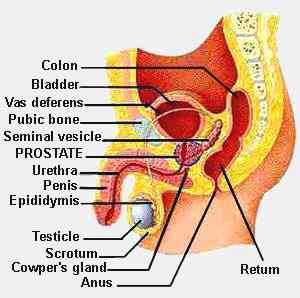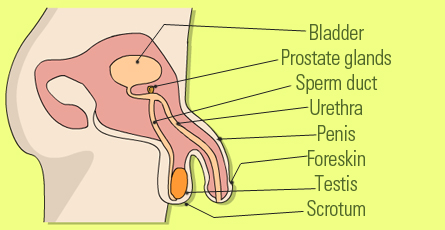The male reproductive system serves three functions. It produces male sex hormones, which allow the system to function and develop; it creates, maintains and delivers sperm for reproduction; and it delivers sperm to the female through semen. Understanding how the male reproductive system functions is important, as it can help you seek out answers to things like infertility.
Male Reproductive System Organs and Function
The male reprodutive organs include external organs which can be seen from the outside and internal organs which are also called accessory organs.


|
External Male Reproductive Organs |
|
|
Organ |
Description |
|
Penis |
This male reproductive organ consists of the root (which is attached to the body), the body (which contains three areas of sponge-like tissue that fills with blood and becomes rigid during sexual arousal) and the glans (which is the tip of the penis). The penis contains many nerve endings and is also covered with skin called foreskin, which is often removed with circumcision. Function: The penis serves as the male organ used to deliver semen to the female during intercourse and also houses the urethra, which is used to transport semen and urine. |
|
Testicles |
The primary male sexual organs, the testicles are egg-shaped and contained within the scrotum. There are two testes, both of which consist of large coils of seminiferous tubules. Function: These tubules produce sperm. The two testes produce testosterone, the primary male sex hormone. |
|
Scrotum |
This is a pouch of skin located below the penis. It is made up of loose skin which holds the testicles. Function: Because sperm must be produced and develop at a temperature slightly lower than body temperature, the scrotum serves as a method of maintaining proper temperature control by contracting or relaxing in order to bring the testicles closer or further away from the body. |
|
Internal Male Reproductive Organs |
|
|
Organ |
Description |
|
Urethra |
The tube located in the penis which carries the urine or sperm to outside the body. During intercourse and ejaculation, only sperm is allowed to flow through the urethra. |
|
Bulbourethral glands (also known as Cowper’s glands) |
Located on the side of the urethra, these glands produce a clear fluid that lubricates the urethra for semen transport and to reduce any acidity in the urethra that is harmful to sperm. |
|
Prostate gland |
A ball shaped gland that is below the bladder, with the urethra running through the gland. The prostate gland produces fluids that make up semen. These fluids also supply nutrients to the sperm. |
|
Epididymis |
Attached to the testes, these coil-like structures take immature sperm and mature them. Once matured, the epididymis stores mature sperm until climax, when they are carried to the urethra by the vas deferens. |
|
Seminal vesicles |
Attached to the vas deferens, these small “pouches” produce fructose, which supplies sperm with energy so that they may swim to fertilize the egg. The liquid produced by the seminal vesicles constitutes the largest single component of semen volume. |
|
Vas deferens |
The vas deferens consists of a muscular tube which moves sperm from the epididymis to the urethra. |
|
Ejaculatory ducts |
These ducts empty into the urethra and consist of the vas deferens and seminal vesicles combining together. |
The Functioning of the Male Reproductive System
The male reproductive system relies on male sex hormones. In addition to testosterone, follicle-stimulating hormones and luteinizing hormones play a part in the male reproductive system.
Testosterone is responsible for the development of male sex characteristics such as facial hair, muscle mass and voice. It also plays a part in fat distribution, bone density, and sex drive. Follicle-stimulating hormone is needed for sperm production. Luteinizing hormone helps make sperm by stimulating the production of testosterone.
Problems with Male Reproductive System
The male reproductive system consists of organs and structures which are quite complicated and don’t always work property. As a result, problems can result, some more serious than others. Some common problems include:
- Low sperm count
- Sexually transmitted infections/diseases
- Cancer of the penis, testes or prostate
- Urethral stricture
- Epididymo-orchitis
- Urinary tract infection
- Erectile dysfunction
- Prostate gland enlargement
- Varicocele
- Infertility

